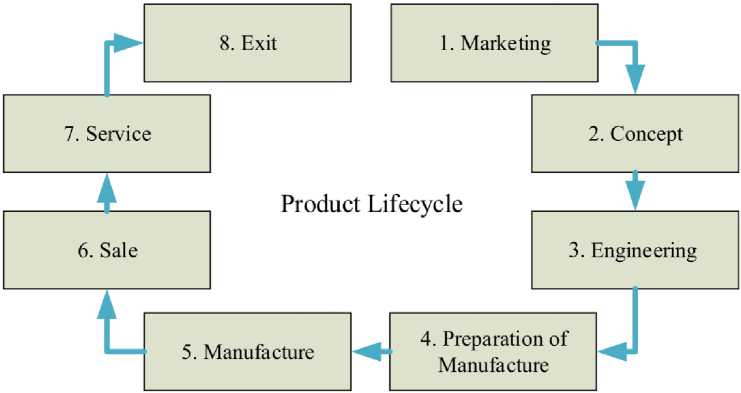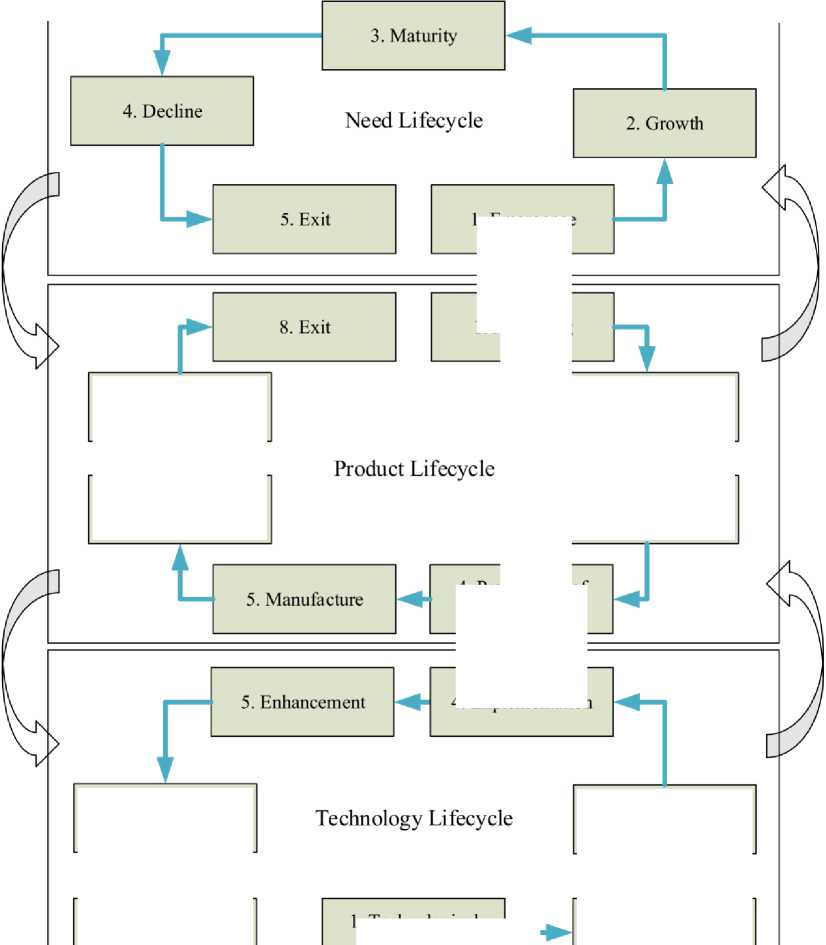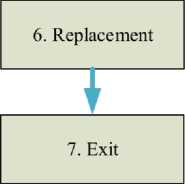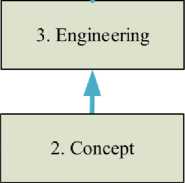Need of developing information systems of managing a technology lifecycle of industrial enterprises
Бесплатный доступ
The following article is aimed at justifying the need of developing new information systems of managing a lifecycle of technologies in order to increase the efficiency of industrial enterprise performance. This necessity was caused by the objective processes happening in the world, specifically globalization of the world economy and further specialization of labour which led to segregation of production facilities from R&D centers developing new types of products and doing market research. In this regard, the competitiveness of industrial enterprises is now primarily to be defined by the efficiency of the technologies used in the production process. However, nowadays the vast majority of information systems are aimed not at managing technologies, but at managing products. The author shows the common ground and differences between the management systems of a product lifecycle and management systems of a technology lifecycle as well as what competitive advantages industrial enterprises will get implementing management systems of a technology lifecycle. At the same time, the transition into such system should not have a revolutionary nature. It can be implemented due to the improvement of the available information systems, with shifting the focus on improving the existing technologies and creating new ones. Upon such transition, industrial enterprises will keep the available competences in developing new types of products and will receive an additional impulse of development due to the increase in efficiency of the technologies used.
Information systems, technologies, management, industry, enterprise management, technology lifecycle management of technology lifecycle
Короткий адрес: https://sciup.org/147232246
IDR: 147232246 | УДК: 005.7 | DOI: 10.14529/ctcr190214
Текст краткого сообщения Need of developing information systems of managing a technology lifecycle of industrial enterprises
Now due to globalization of the world economy, there is a stiffer competition among industrial enterprises [1]. One of the ways to increase the performance efficiency is to implement information systems allowing the management to make justified managerial decisions [2]. However, the introduction of modern information systems does not guarantee the success of the enterprise in the market yet. To ensure the efficiency of their implementation, it is necessary to carefully approach the choice of software products, to consider specific nature of tasks solved and to devise a strategy of informatization of the enterprise.
Product lifecycle
The concept of a lifecycle (of enterprises, goods, technologies, etc.) is widely used to describe the phenomena occurring in social and economic systems [3]. The largest set of models is presented by the models of an enterprise lifecycle [4]. Next, there are the models of a product lifecycle [5], and models of information systems lifecycles are described the best in this category [6]. The models of a technology lifecycle are least worked through [7].
The common feature of all of them is that they begin with a ‘birth’ stage and finish with a ‘death’ stage which suggests that there is a certain objective regularity inherent in all the objects of the material world.
A Product Lifecycle is a set of processes associated with a certain product from the moment of recognizing the need in the society to its utilization (Fig. 1).
Currently the information systems of a product lifecycle management (PLM – Product Lifecycle Management) [8, 9] are widely used and aimed at considering the features of all the stages of a product lifecycle. The PLM systems promote reducing the time of developing a product, accelerating its marketing and improving the quality and reliability of products. These are parts of PLM [10]:
-
• Product Data Management, PDM;
-
• Computer Aided Design, CAD;
-
• Computer Aided Engineering, CAE;
-
• Computer Aided Manufacturing, CAM;
-
• Computer Aided Production Planning, CAPP;
-
• Manufacturing Process Management, MPM;
-
• Digital Manufacturing, DM;
-
• Maintenance, Repair and Operations or Overhaul, MRO.
Although PLM solutions also include systems of production planning (Computer Aided Production Planning) and a production management systems (Manufacturing Process Management), such systems are a part of a product lifecycle management system, i.e. a production process is merely a secondary process of product development.

Fig. 1. Product lifecycle
Let us address the “Need – Product – Technology” sequence once again. It is objectively possible to say that neither the need nor the product or technology remain constant as they change over time. Three strategies of behaviour are possible, depending on what management of the company is focused on (Table 1).
Table 1
Possible behaviour strategies
|
No. |
Focus |
Actions |
Notes |
Production expenses |
|
|
Advantages |
Disadvantages |
||||
|
1 |
Need |
Market research |
As a result of a market research, we define the needs to satisfy which new products and technologies of their production are developed |
An opportunity to develop new desired products |
High costs of a market research, the overstated cost of the product made |
|
2 |
Product |
Developing new kinds of products |
Revolutionary products often appear not as a result of a market research, as in society there are no needs they can satisfy yet, but as a result of scientific researches. Only then new products form new needs for society |
Possibility of creating a new market and its monopolization in case of success of a revolutionary product |
High costs of developing products, overestimated cost of the product made. Risks connected with impossibility of production of a revolutionary product using old technological facilities |
|
3 |
Technology |
Improving technologies |
Improvement of technologies allows us to reduce the production cost of the existing products. Significant changes in technologies make it possible to produce new products whose production was impossible using old technologies |
Improvement of the operating technologies, reducing the cost of the products made. High competitiveness is reached by the production companies which master advanced technologies first |
Lack of opportunity to compete due to unique goods |
Thus, it is obvious that the needs, product and technology are interconnected and interdependent. And it is the distinctive nature of company activities which defines the focus. In particular, production of standard products is a characteristic of industrial enterprises, so the need for producing revolutionary products arises quite seldom. The competitiveness of manufacturing enterprises is generally defined by the ability to offer low production cost due to the best possible processes (technologies).
A technology lifecycle
Summing up, modern industrial enterprises which produce standard products or fulfil orders of product developers do not have considerable advantages by implementing strategies focused on needs or products. Focusing on technologies is what improves the existing technological processes.
The interrelation of lifecycles of a need, a product and technology is presented in Fig. 2.
As it was shown earlier, the concept of a lifecycle can be also applied to technologies. Most often by the stages of a technology lifecycle they mean a certain degree of maturity of technological processes: the latest technology, the advanced technology, the modern technology, the older technology, the outdated technology [11]. Dividing technologies according to this principle does not set accurate requirements to information systems of managing a technology lifecycle. Therefore we shall define the stages of technology lifecycles in a similar way to a product lifecycle (Table 2). It is clear from Table 2 that at the moment information systems in the field of engineering design of new technologies are well implemented as these systems were developed within management systems of a product lifecycle. While the systems connected with supporting the stages of technological forecasting, enhancing, replacement and exit of technology require further improvement. It should be noted that now the systems of improvement of technologies based on process approach – Business Process Management (BPM) are being massively developed [12, 13]. The interrelation of lifecycles of a need, a product and technology is presented in Fig. 2.

1. Technological forecasting


1. Emergence
1. Marketing

4. Preparation of Manufacture
4. Implementation

Fig. 2. Interrelation between a lifecycle of a need, a product and technology
Table 2
Stages of a technology lifecycle
|
Stage |
Content |
|
1. Technological forecasting |
Forecasting of changes in technical characteristics and forecasting of developing technologies |
|
2. Сoncept |
Development of concepts of new technologies |
|
3. Engineering |
Design of a new technology in order to implement it in a certain enterprise |
|
4. Implementation |
Implementation of a new technology |
|
5. Enhancement |
Any technology requires improvement and enhancement as a result of which production costs decrease |
|
6. Replacement |
Replacement of one technology by another one is often followed by a set of structural changes in the company |
|
7. Exit |
Terminate utilizing a technology |
One more drawback of aiming information systems at a product (managing a product lifecycle) is that some processes in the enterprise are not directly connected with a new product release, such as logistics, accounts department, HR, etc. Thus, these processes are often out of sight of the management and are not improved at the same time as a product. Many industrial companies failed not because they could not develop and produce new products but because the production of these products on the basis of inefficient technologies did not allow them to be competitive. Development of the information systems allowing the industrial companies to be focused on technologies will result in gaining competitive advantages.
Earlier the author [14] showed that a term ‘technology’ has a broad meaning and is not limited to production technologies. Development and implementation of management systems of technology lifecycles will allow us to get the effective management of all the processes of the enterprise back on track.
Conclusion
The following article the need of developing a new class of information systems, namely, management systems of a technology lifecycle which can become the basis for improving competitiveness of the enterprises is shown. Transition from management systems of a product lifecycle to management systems of a technology lifecycle is objectively necessary for further development of the industrial enterprises.
Management systems of a technology lifecycle have to include both the systems which are already available and connected with managing a product lifecycle, and the new systems necessary for improving the available technologies and developing new ones.
Список литературы Need of developing information systems of managing a technology lifecycle of industrial enterprises
- Управление промышленными предприятиями: стратегии, механизмы, системы: моногр. / О.В. Логиновский, В.Н. Бурков, И.В. Буркова и др.; под ред. О.В. Логиновского. - М.: ИНФРА-М, 2018 - 410 с.
- Логиновский, О.В. Повышение эффективности работы предприятия на основе современных управленческих технологий и информационно-аналитических систем / О.В. Логиновский, К.А. Коренная // Автоматизация и управление промышленными предприятиями: докл. науч.-техн. конф. всерос. форума «Информационное общество-2015: вызовы и задачи». - Челябинск: Издат. центр ЮУрГУ, 2015. - С. 4-38.
- Новиков, Д.А. Теория управления организационными системами / Д.А. Новиков. - М.: Изд-во физ.-мат. лит., 2012. - 604 с.
- Щербакова, Е.А. Системный подход к управлению жизненным циклом организации / Е.А. Щербакова // Организатор производства. - 2013. - № 3 (58). - С. 28-30.
- Павлов, Н.В. Управление жизненным циклом продукта / Н.В. Павлов - СПб.: Санкт-Петербургский политехнический университет Петра Великого, 2014. - 219 с.
- Зараменских, Е.П. Управление жизненным циклом информационных систем: моногр. / Е.П. Зараменских. - Новосибирск: Изд-во ЦРНС, 2014. - 270 с.
- Управление жизненными циклами промышленных технологий / В.Н. Кононов, Е.С. Замбржицкая, Р.Р. Дема, М.В. Харченко // Вестник Омского ун-та. Сер. «Экономика». - 2018. - № 1 (61). - С. 76-87.
- DOI: 10.25513/1812-3988.2018.1.76-87
- Управление жизненным циклом продукции / А.Ф. Колчин, М.В. Овсянников, А.Ф. Стрекалов, С.В. Сумароков. - М.: Анахарсис, 2002. - 304 с.
- Кульга, К.С. Автоматизация технической подготовки и управления производством на основе PLM-системы / К.С. Кульга. - М.: Машиностроение, 2008. - 275 с.
- Saaksvuori, A. Product Lifecycle Management / A. Saaksvuori, A. Immonen. - Berlin: Springer, 2008. - 254 p.
- DOI: 10.1007/978-3-540-78172-1
- Мартынов, О.Ю. Жизненный цикл технологий в производстве наукоемкой продукции / О.Ю. Мартынов // Вектор науки Тольяттинского государственного университета. - 2012. - № 1. - С. 69-72.
- BPM CBOK Version 3.0: Guide to the Business Process Management Common Body of Knowledge / T. Benedict, N. Bilodeau, P. Vitkus et al. - Create Space Independent Publishing Platform, 2013. - 446 p.
- Fundamentals of Business Process Management / M. Dumas, M. Rosa, J. Mendling, H. Reijers. - Berlin: Springer, 2018. - 527 p.
- DOI: 10.1007/978-3-662-56509-4
- Голлай, А.В. Генезис понятия «технологическое развитие» / А.В. Голлай // Управление в современных системах. - 2018. - № 3 (19). - С. 20-24.


